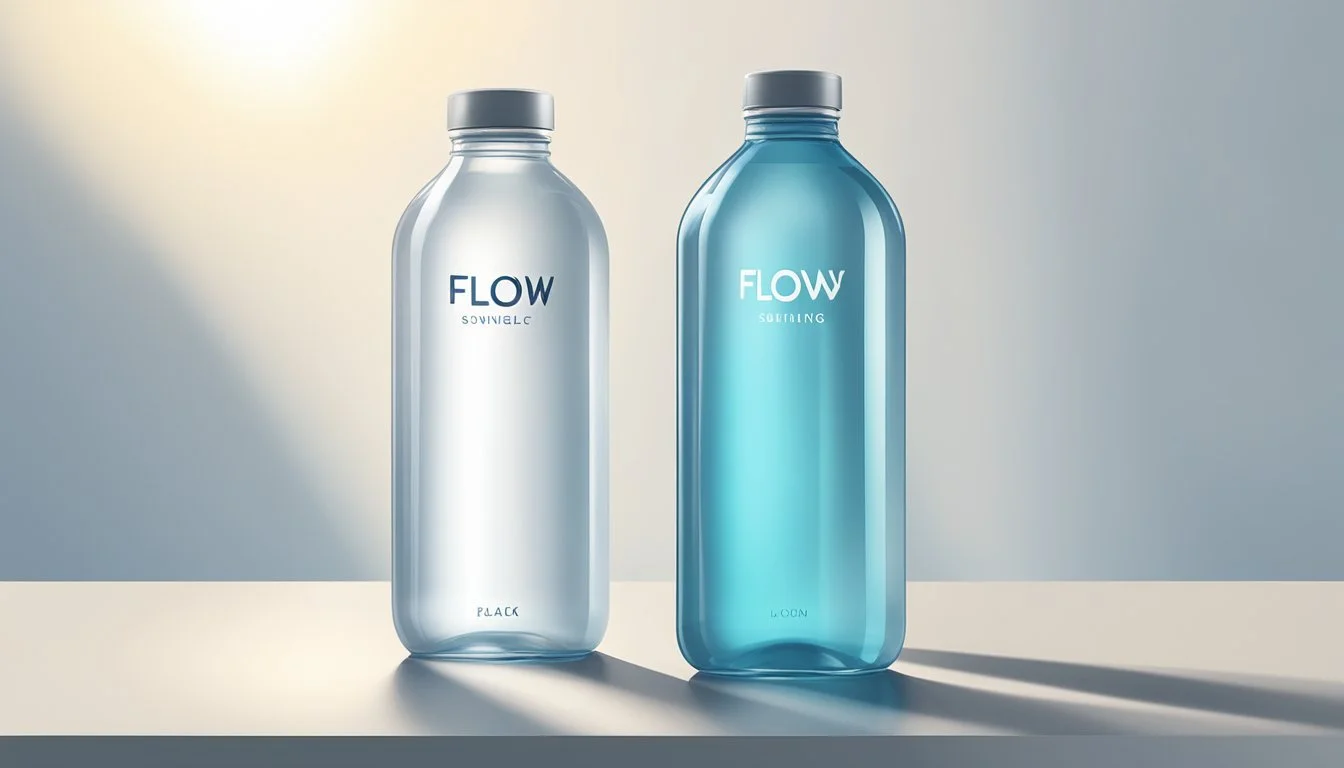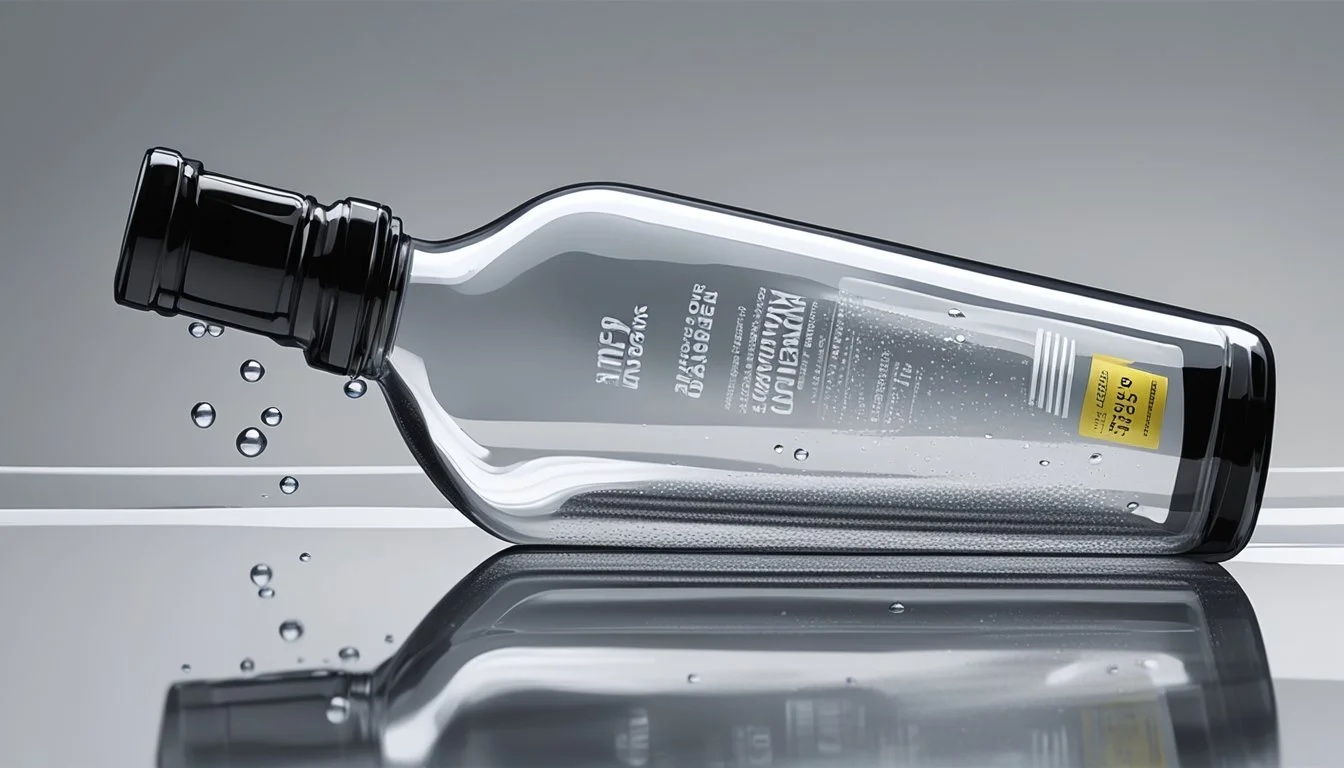Flow vs. Blk
Comparing the Best Bottled Waters
When it comes to choosing between Flow and blk. bottled water, consumers often find themselves weighing quality against uniqueness. Flow, known for its alkaline properties and sustainable packaging, offers a refreshing and neutral taste, making it a popular choice for those who prioritize both flavor and environmental impact. The milk box-style design adds a fun and practical element, enhancing its appeal.
In stark contrast, blk. water stands out due to its deep black color, infused with fulvic trace minerals. This bottled water has intrigued many with its unique appearance and potential health benefits. Despite its steep price point, it continues to garner attention for its distinctive look and the promise of enhanced hydration.
For those seeking a crisp, neutral taste coupled with eco-friendly packaging, Flow emerges as the superior option. However, for individuals curious about an innovative and mineral-rich hydration source, blk. water offers a compelling alternative.
Comparing the Contenders: Flow and Blk Water
Flow and blk. water both stand out in the premium bottled water market, but they offer distinct characteristics. This section dives into key aspects like brand background, water source, and unique advantages.
Brand Overview
Flow: Flow is a Canadian brand known for its natural spring water. It emphasizes an eco-friendly approach, offering water in tetra packs that are 100% recyclable. The brand also highlights its commitment to sustainability.
blk. water: blk. water, often noted for its striking black appearance, positions itself as a high-end hydration source. The black color is due to the presence of fulvic trace minerals and humic acid. blk. water markets itself as a health-focused option, promoting potential benefits like improved hydration and mineral intake.
Origin and Source
Flow: Flow sources its water from natural springs in Ontario and Virginia. This spring water is claimed to have a naturally occurring pH balance of 8.1, making it slightly alkaline. The water undergoes minimal processing to maintain its natural properties.
blk. water: blk. water uses purified water to which fulvic and humic acids are added. These acids, derived from decomposed plant matter, give blk. water its unique black color. This process is meant to infuse the water with a range of trace minerals and electrolytes.
Unique Selling Points
Flow: One of Flow's key selling points is its packaging. The eco-conscious tetra packs are designed to reduce plastic waste. Flow also highlights its naturally alkaline properties and the purity of its spring water. It appeals to consumers looking for an environmentally friendly and health-focused option.
blk. water: blk. water's striking appearance differentiates it from conventional bottled waters. The addition of fulvic and humic acids, which some suggest may aid in nutrient absorption and gut health, positions blk. water as a functional beverage. It aims to attract health-conscious consumers willing to pay a premium for perceived benefits.
Both Flow and blk. water have carved out niches in the competitive bottled water market with their unique features and marketing strategies. Each brand offers distinct advantages, catering to different consumer preferences and priorities.
Water Quality and Health Benefits
Flow and Blk bottled waters both offer unique characteristics that can influence water quality and health benefits. These factors include pH levels, mineral content, potential for detoxification, and their impact on energy and immune function. Here’s how they compare in these crucial areas.
pH Levels and Alkalinity
Flow water has an alkaline pH of 8.1, which may help neutralize acid in the body. An alkaline pH level is often sought for its potential to improve metabolic functions and reduce acidity-related health issues.
Blk water, infused with fulvic trace minerals, has a pH closer to neutral at around 7. This neutral pH aids in maintaining the body’s natural balance, providing a different approach to hydration compared to more alkaline waters.
The varying pH levels between Flow and Blk waters cater to different needs and preferences.
Mineral Content and Hydration
Flow water contains essential minerals such as calcium, magnesium, and potassium, which can enhance hydration and support bodily functions. Calcium and magnesium are particularly important for bone health and muscle function.
Blk water is enriched with fulvic trace minerals. These minerals are known for their role in nutrient absorption and maintaining electrolyte balance, thereby contributing to optimal hydration. The unique mineral profiles of both waters can benefit overall health by ensuring adequate intake of key nutrients.
Below is a comparison of some mineral content:
Mineral Flow Water Blk Water Calcium Yes Trace Amounts Magnesium Yes Trace Amounts Potassium Yes Not Specified Fulvic No Yes
Potential for Detoxification
Flow’s high alkaline pH may support the body’s detoxification processes by promoting a less acidic environment, potentially aiding kidney function. Detoxification involves the removal of toxins by flushing them out of the body, often enhanced by adequate hydration.
Blk water’s fulvic trace minerals play a significant role in detoxification. Fulvic acid is known to bind with toxins and heavy metals, assisting in their removal from the body. This makes Blk water a unique option for those seeking additional detoxifying benefits.
Impact on Energy and Immune Function
The electrolytes in Flow water, including potassium and magnesium, can enhance energy levels by supporting metabolic processes and reducing feelings of fatigue. These electrolytes are also vital for maintaining hydration, further aiding energy production.
Blk water’s fulvic minerals may improve nutrient absorption, which can indirectly boost energy levels and support immune function. Better absorption of nutrients ensures the body has the necessary resources to maintain energy and bolster the immune system.
Both Flow and Blk water contribute to overall vitality through their unique compositions.
Consulting Healthcare Professionals
When choosing between Flow and Blk bottled waters, it is advisable to consult with a healthcare professional. They can provide personalized advice based on individual health needs and conditions.
Healthcare professionals can help determine which water type may be more beneficial, considering factors such as dietary requirements, existing health conditions, and lifestyle.
Engaging a healthcare professional ensures a well-informed decision tailored to enhancing health and hydration.
Taste Experience
When evaluating bottled waters like Flow and blk., the taste is often a crucial factor. This section explores the flavor profile comparison and consumer feedback for each brand.
Flavor Profile Comparison
Flow water is often described as having a clean, slightly sweet taste that comes from its natural alkaline properties. It maintains a crispness that feels refreshing to most consumers.
By contrast, blk. water features a unique profile due to the inclusion of fulvic minerals. This addition results in a neutral to subtle flavor, which some find slightly earthy. Unlike many flavored waters, blk. avoids artificial flavors and sweeteners, relying solely on its mineral content for taste.
Comparatively, Flow's straightforward and pure taste often appeals to those who prefer minimal intervention, while blk.'s distinctive flavor can be an acquired taste for some.
Consumer Preferences and Feedback
Flow generally receives positive reviews for its smooth, refreshing taste. Consumers appreciate its purity and how it doesn't linger with any aftertaste. People who are sensitive to taste changes in bottled water often prefer Flow for its consistent quality.
On the other hand, blk. water garners mixed reactions. Some consumers love the hint of earthiness and appreciate the unique presentation. However, others find it less appealing compared to traditional bottled water flavors.
Feedback indicates that individuals who favor mineral-rich or electrolyte-enhanced waters might lean towards blk., while those preferring a conventional, crisp water experience might choose Flow. Customer reviews often highlight these preferences, emphasizing personal taste as a significant factor.
Economic and Environmental Considerations
Examining Flow and Blk bottled water brands requires a thorough look at economic factors and environmental impacts. Key points include cost, sustainability, waste management, and packaging convenience.
Cost Analysis
When evaluating costs, it's important to consider both initial and long-term investments. Flow water typically costs more per unit, attributed to its packaging and brand positioning. They focus on organic sourcing and eco-friendly packaging. Blk water, while often seen as a premium product due to added minerals, may or may not have a higher cost per bottle depending on region and sales dynamics.
Retail prices fluctuate based on market demand and promotional activities. Bulk purchases can mitigate costs, but buyers should analyze price per liter for accurate comparisons. The investment in either brand must account not only for purchase price but also for the value proposition they offer regarding health benefits and environmental initiatives.
Sustainability and Carbon Footprint
Flow emphasizes sustainability as a core part of their mission. Their packaging uses renewable materials, reducing the brand’s carbon footprint. Flow's practice of sourcing water from remote, less-populated areas further helps in maintaining eco-friendly operations. They also aim for carbon-neutral practices through various offsets.
Blk water, while innovative for using fulvic minerals, might not place the same extensive focus on eco-friendly packaging and carbon neutrality. Comparing both brands, Flow’s commitment to reduced carbon footprint and sustainable sourcing gives it an edge. Consumers particularly inclined towards eco-friendly products might find Flow’s offerings more aligned with their values.
Waste Management and Plastic Pollution
Flow water uses recyclable and often recycled materials for their packaging, substantially lowering the amount of non-biodegradable waste. Their use of paper-based packaging also reduces reliance on plastic bottles, which are major contributors to global plastic pollution.
Blk water, typically sold in PET plastic bottles, contributes to the ongoing issue of plastic waste, unless consumers diligently recycle. The environmental impact of plastic pollution from bottled water is significant, and brands that minimize this impact, like Flow, stand to gain favor among environmentally conscious consumers.
Packaging and Convenience
Both brands offer unique packaging solutions aimed at consumer convenience. Flow’s tetra paks are lightweight, durable, and easy to carry. This packaging style not only differentiates them on store shelves but also aligns with eco-friendly narratives.
Blk water’s packaging, primarily in PET bottles, offers convenience due to widespread familiarity and ease of recycling procedures in many areas. However, PET bottles are less sustainable compared to Flow’s innovative solutions. Reusable bottles are another consideration; consumers using third-party reusable containers for either brand can reduce environmental impact and possibly save on costs over time.
Careful analysis of these factors helps consumers make informed decisions aligning with their economic constraints and environmental priorities.
Assessing Safety and Risks
When comparing Flow and Blk bottled water, it's crucial to evaluate contaminant levels, microplastic contamination, filtration and disinfection methods, and scientific evidence supporting their safety claims.
Contaminant Levels
Contaminants in bottled water can range from heavy metals to chemical compounds. Flow water undergoes rigorous testing to ensure that it is free from harmful substances. Independent tests have revealed that Blk water contains minimal contaminants, attributed to its unique filtration process.
Flow's Testing and Certification:
Regular testing for harmful substances
Certifications from recognized bodies
Blk's Unique Composition:
Minimal contaminants due to fulvic trace minerals
Regular quality checks
Handling Microplastic Contamination
Microplastic contamination is a pressing concern. Both Flow and Blk have taken steps to limit this issue.
Flow employs several stages of filtration. This includes removing microplastics effectively. Blk, while containing naturally derived minerals, is also tested for microplastic contamination.
Flow’s Microplastic Measures:
Multiple filtration stages
Regular testing for microplastics
Blk’s Approach:
Natural ingredient vigilance
Regular checks for synthetic contaminants
Scrutinizing Filtration and Disinfection
Filtration and disinfection processes are key to water safety. Flow uses advanced filtration technologies, including reverse osmosis, to ensure purity. They also utilize UV disinfection to kill any present pathogens.
Blk water, with its unique black color, harnesses natural filtration methods tied to fulvic minerals. This helps remove many harmful substances without extensive chemical treatments.
Flow’s Filtration Process:
Reverse osmosis
UV disinfection
Blk’s Natural Filtration:
Fulvic trace minerals
Minimal chemical treatments
The Role of Scientific Research and Evidence
Scientific research supports the safety measures employed by both brands. Studies affirm that Flow’s multi-stage filtration is effective at removing a wide range of contaminants. This includes heavy metals and organic toxins.
Research on Blk water highlights the benefits of fulvic minerals in enhancing nutrient transport and reducing contaminants organically. Both brands rely heavily on scientific validation to ensure consumer safety.
Flow’s Evidence-Based Approach:
Supported by scientific studies
Effective contaminant removal
Blk’s Science-Backed Claims:
Benefits of fulvic trace minerals
Scientific validation of safety
Diversity of Bottled Water Types
Bottled water comes in various forms, each providing unique benefits and characteristics. The key differences lie in their sources, filtration techniques, and whether they are still or carbonated.
Comparison of Different Bottled Waters
There are several types of bottled water on the market, including spring water, mineral water, and purified water.
Spring water comes from underground formations and must be collected either at the source or through a borehole. Mineral water, like San Pellegrino and Perrier, contains naturally occurring minerals, providing distinct tastes and potential health benefits. Purified water has undergone treatment processes like deionization or reverse osmosis to remove impurities.
The Spectrum of Filtration Techniques
Filtration methods for bottled water vary significantly. Micron filtration uses a fine filter to remove particles and microorganisms. Chlorination adds chlorine to eliminate bacteria but may affect taste. More advanced methods like reverse osmosis and deionization remove a broader range of contaminants, resulting in purified water.
Other techniques include carbon filtration, which removes chlorine and improves taste, and UV treatment that uses ultraviolet light to disinfect water. Each method has its benefits and limitations, impacting the final product's quality and purity.
Distilled vs. Spring vs. Mineral Water
Distilled water is produced by boiling water, capturing the steam, and condensing it back into a liquid, removing most impurities. It lacks minerals, making it suitable for medical uses but less flavorful for drinking. Spring water, naturally filtered through underground rocks, retains essential minerals.
Mineral water, sourced from mineral springs, contains higher quantities of dissolved minerals like calcium and magnesium. It’s often favored for both its taste and potential health benefits. Spring and mineral waters are generally sought after for their natural origins and rich mineral content.
Carbonated Water Options
Carbonated water, including variants like club soda, seltzer, and sparkling water, is infused with carbon dioxide gas. Club soda contains added minerals such as potassium sulfate and sodium chloride, enhancing its flavor profile. Seltzer water is carbonated but typically lacks these added minerals.
Popular brands like Perrier and San Pellegrino offer natural sparkling mineral water, which combines carbonation with naturally occurring minerals. These products are preferred for their refreshing qualities and distinct tastes, appealing to those seeking a sophisticated drinking experience.
Regulations and Industry Standards
Both Flow and Blk bottled water brands follow stringent regulations to ensure quality and safety. Rigorous compliance with standards is necessary to meet legal requirements and maintain consumer trust.
Compliance with EPA and FDA
In the United States, bottled water is regulated by the Food and Drug Administration (FDA), while tap water falls under the Environmental Protection Agency (EPA).
FDA's role:
The FDA sets quality standards for bottled water, which must match EPA standards for tap water.
These standards include regulations on contaminants and labeling requirements.
Flow and Blk must regularly test their water for various contaminants, such as bacteria, chemicals, and heavy metals, ensuring they meet safety standards.
Brand Accreditation and Certifications
Accreditation and certifications serve as proof of a brand's commitment to maintaining high standards. Flow and Blk seek certifications from reputable organizations to gain consumer confidence.
Certifications often include:
ISO 22000: Ensures food safety management.
NSF Certification: Indicates the product meets strict health standards.
International Bottled Water Association (IBWA) membership: Requires adherence to additional quality standards and regular audits.
Flow and Blk's compliance with these certifications reflects their dedication to delivering safe, pure bottled water to consumers.
Conclusion and Recommendations
When comparing Flow and blk. water, several factors are essential to consider. Flow boasts natural spring water sourcing with claims of organic and alkaline properties. This positions it similarly to brands like Fiji Water, Evian, and Voss. Their focus on sustainable packaging is a significant plus for environmentally-conscious consumers.
blk. water stands out with its unique appearance and the inclusion of fulvic trace minerals. Though it promotes potential health benefits, these claims often require further research. This places blk. water in a niche category compared to traditional options like Pure Life, Aquafina, or Dasani.
Taste and Source: Flow offers a clean, smooth taste akin to what you find in premium brands such as LifeWTR and Smartwater. Blk. water's taste may be an acquired preference due to its mineral content and color, which may not appeal to everyone.
Packaging and Sustainability: Flow is packaged in eco-friendly cartons, aligning with consumer trends towards sustainability. In contrast, blk. water uses standard plastic bottles, more common in brands such as Poland Spring and Arrowhead.
Health Considerations: For those focused on pH levels and potential health benefits, Flow's alkaline water can be a deciding factor. Meanwhile, blk. water's unique mineral content provides an alternative for those interested in unconventional health products.
Price Point: Both Flow and blk. water fall into the premium price category, similar to Core Hydration and Voss. Consumers should be prepared for a higher price point compared to mass-market options like Nestlé Pure Life and Ice Mountain.
Informed consumers should weigh these aspects based on individual preferences and health goals. For those seeking sustainability and smooth taste, Flow is a commendable choice. For those curious about unique health benefits and unconventional options, blk. water offers an intriguing alternative.
More About Flow
Flow vs Whole Foods Italian Still Mineral water: Which Bottled Water is Better?
Mountain Valley Spring Water vs Flow: Which Bottled Water is Better?





